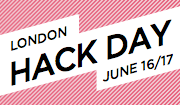Property Is Theft
19th-Century French politician Pierre-Joseph Proudhon might have coined the phrase, but it's still pretty relevent today. As a soon-to-be-freelance web designer and photographer, I was particularly alarmed to read Sion Touhig's piece at The Register, about how the glut of freely- (or cheaply-) available images on the web has "devasted" the freelance photography and photojournalism sector. Not only is content on the web more easy to pinch, but also the rise in "user generated content" has made things increasingly difficult. He states:
"User Contributed Content should be more accurately termed 'Audience Stolen Content', because media groups rarely pay for Citizen Journalism images and more often than not, either claim the copyright or an all-encompassing license from contributors, when they send their pictures in. That's a copyright grab in all but name."The article runs to three pages and make many other salient points, but this one stuck out too:
"The perception is "if it's on the web, it's either free, or I'm gonna nick it anyway because, hey, 'they' can afford it". The reality is that there are now more copyright-free or near-free images on the web than copyright images. Most of them will be on Flickr (owned by Yahoo!), MySpace (owned by Rupert Murdoch's News Corporation) or the major corporate image portals. Neither Flickr nor MySpace exist to commercially leverage images, but clients now go there trawling for free content, so they don't have to pay a photographer for it. It has caused a crash in the unit cost of any images which aren't given away and which are licensed for profit."As a victim of copyright theft in the past, I can entirely sympathise with his point of view. In my case, I was minding my own business reading one of the broadsheets' weekend colour suppliments a few years ago, when I stumbled across a picture which I knew incontrovertibly to have been stolen from one of my websites and used without my permission. After writing an incensed letter to the paper's picture editor, they freely admitted that it was their fault (blaming a lazy researcher for not checking the copyright status of the image!) and agreed to pay me their standard repro fee.
It took another 4 letters and six months for them to finally honour their promise. And that was for a picture which wasn't particularly important or valuable, and would not have earned me anything anywhere else - it was just for the principle of it that I pursued them. What would have happened if I hadn't spotted it? I wonder how many more times newspapers get away with this sort of thing - not to mention the millions of folks online who can trawl the web for all of your pictures and do with them what they will.
And I'm afraid that's why you'll find I put a copyright watermark in all my images which I put online - they're usually only 600x400 resolution too. And my Flickr images aren't tagged with a Creative Commons licence. Once bitten, twice shy.
On a related note, recently a client gave me a brief, and I worked up a proposed site layout. But despite me following the brief, the client was not happy and has basically admitted they want me to rip off the design of another site! I flatly refuse to do so. Asking me to do this would basically be asking me to throw away my professional integrity and risk being sued for breach of copyright.
Fortunately, there was PR agency inbetween me and the client in question, who managed to mediate the situation. They were pretty much in agreement with me that it wasn't not a healthly thing to be suggesting. And from a prospective customer's point of view, I wouldn't be too impressed if I found a site which had obviously pinched a design from a competitor - that wouldn't say much for the company's buisness ethics!







4 comments:
Great article Caz and I so agree with the whole perception and understanding of copyright issues raised here. I'm always alarmed by the amount of people that come on one of my web courses and ask can't I just take that photo, but it's on the web etc, and these are very bright / professional people.
I can only point out that you wouldn't take a competitor's and / or company's brochure and cut it up and put it back together as your own ... so why their website and images ...
I like the analogy Sheila, I'll have to remember it if ever I need further ammunition!
I'm always a little concerned when uploading to flickr, so usually I downsize the images. But nowhere near your 800x600. I want to be able to show pictures when I'm at friends etc so I'm usually around the lower 1000s. Which haven't really been a big problem mostly because of my low rate of taking photos. But I got a new lovely camera for Christmas, which has increased my triggerhappines with a few 100%. Also the pictures look much better now.
But I'm to lazy to watermark everything. I just want to upload as simple and painfree as possible, usually using flock.
How do you go about the watermarking?
Eystein, I've got an Action set up in Photoshop, so I use that for the watermarking. Since I'm likely to be doing crop/levels on most things before they get put online, it's only one button click! I could batch process them if I pulled my finger out, but that would always put the watermark in the same place - sometimes I want to move it to somewhere less obvious (but still visible).
Post a Comment